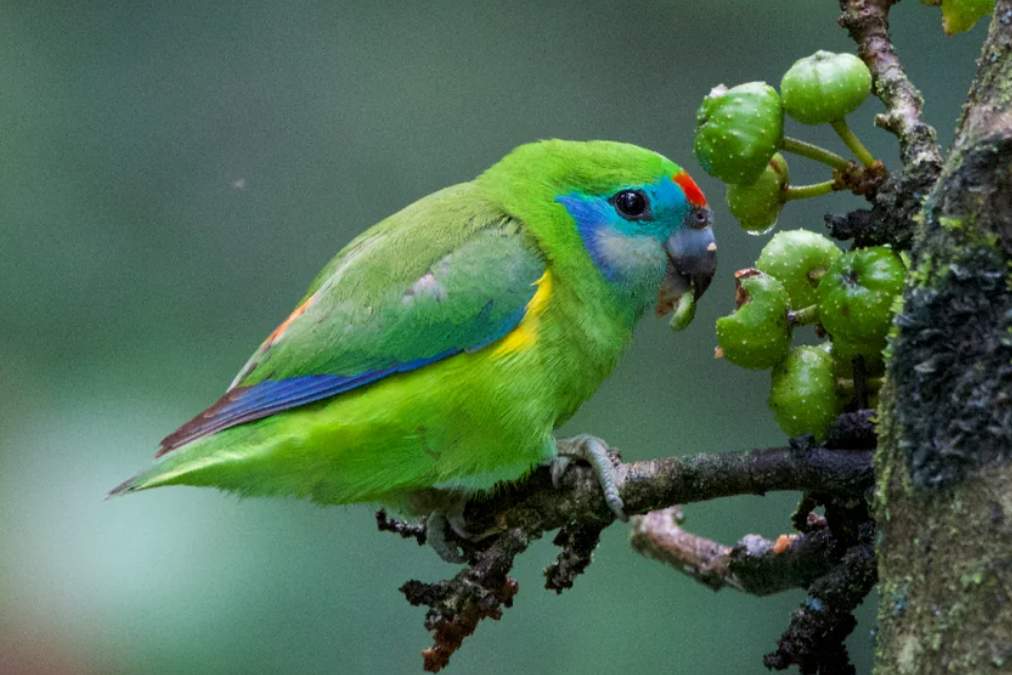Family: Topknot Pigeon (Lopholaimus antarcticus) belongs to the family Columbidae
Behavior: In the early years of colonization on the east coast, pioneers discovered Topknot Pigeons were a useful source of food. At the time, flocks of several thousand Topknot Pigeons were typical. Today, the majority of the east coast rainforest has disappeared, as has the population of Topknot Pigeons. They continue to occupy their historic habitat wherever rainforest exists, although flocks rarely exceed 200 birds and are frequently less than 50.
The Topknot Pigeon moves from place to place to concentrate on different fruiting trees and is highly nomadic. It seems that some flocks traverse the full length of the Queensland coast. Individuals have occasionally turned up as far south as Tasmania. On the other hand, other flocks seem to never move far. Their flight is direct, swift, and seemingly effortless.

Identification: Both adult sexes are similar. Crest on hind crown rust-red; crest on cere and forehead slate-grey. The feathers on the back of the neck are gray and bifurcate, with darker bases, giving a streaked effect; the back, rump, and base of the tail are slate-grey; the rest of the tail is black with a 10 mm wide slate-grey band near the tip; and the flight feathers are black. Underparts are paler grey than the upper parts, with bifurcate feathers over the neck and breast. Eyes are golden yellow with a red outer ring. Bill is red with brown tips. The feet are purple-red, and the claws are grey. The immature bird looks like an adult, but its crest is vestigial, its neck feathers are not bifurcate, and its tail band is duller. The eyes, bill, and toes are browner. The downy young is a sandy color.
Diet: The Topknot Pigeon’s diet varies from year to year and season to season based on the fruiting of various forest trees, although the key food trees are similar between districts. Some, like the bangalow palm, fruit so regularly that the appearance of some flocks gives the impression of regularity. On the south coast of New South Wales, there is a fairly regular cycle of food through the fruiting of ironwood, pigeon berry ash, hard aspen, lilly-pilly, white beech, the small-leafed fig, and cabbage palm. In northeastern New South Wales, the Topknot Pigeons base their diet on the fruits of several figs, bangalow palm, lilly-pilly, blue quandong, saffron heart, yellow tulipwood, and corkwood.
They may also leave the forest to feed on the berries of the introduced camphor laurel, grown as a shade tree in paddocks. In the forest, the Topknot Pigeon feeds in the canopy and lower levels and never comes to the ground. It gets most of its water from leaves, although in dry conditions, it sips at streams, perches on rocks, or clings to low-hanging limbs. When feeding, it hangs upside down on clumps of foliage and clings to very thin branches, flapping its wings loudly and dislodging showers of fruit.
Courtship: The Topknot Pigeon differs from other pigeons in its courtship display and plumage. When coupling, the male lands on a limb near the female, quickly half-spreads his wings and tail, and keeps his body erect. The two birds, their crests fully erect, entwine their necks. In the bowing display, the male, crest-erect, presses his bill to his breast. The body is held upright and then driven forcibly downward.
At the lowest point, there is a squeak, and then the body is raised. The bow, which is presented in bouts, resembles that of no other pigeon. There is no noticeable relationship between the Topknot Pigeon and other well-defined groups of pigeons, although its bifurcate neck feathers and broken iris are paralleled in the fruit-doves, as are its size, tail structure, and color pattern in the imperial-pigeons.

Vocalizations: Usually silent except for a short, sharp screech during feeding and a low squeak on display. Soft, low coos are heard infrequently. The first sound, “coo-oo, eee,” may be connected to nestlings. The second call, “coo-oo, ooo,” is noticeably louder but still gentle. The third call, “cor-or,” is described as “a quiet, croaky, almost guttural utterance,” like the call of the domestic pigeon.
Nesting and Breeding: Topknot Pigeon nesting and breeding occur in June–December, but mainly in the spring. The nest, which is made of sturdy sticks from turpentine and eucalyptus trees, has been described as occasionally fragile but usually robust. Some nests have substantial platforms of sticks 250 mm in diameter and 50–70 mm deep, but some are small and flimsy and 2–30 meters high in the outer branches.
Eggs and Incubation: Topknot Pigeon lays one egg, glossy white, oval, about 43 x 29 mm. The incubation period is about 22–23 days for both sexes. Young fledge in 23–26 days.
Distribution: Topknot pigeons are found in coastal eastern rainforests from the Cape York Peninsula to about Ulladulla, NSW. These pigeons travel vast distances in pursuit of fruit-bearing trees, and they occasionally venture farther eastward into Victoria than their typical southern range. The species used to be extremely common in the Australian rainforest, but shooting and forest clearing caused the population to fall.
Races: There are no races
Other Names: It is also known as the Flock Pigeon.
Size: Topknot Pigeon measures 420–450 mm in length.
Taxonomy: While Captain Cook’s ship endeavor was laid up in 1770 at the present site of Cooktown, the crew, seeking fresh food, shot some pigeons. The botanist of the expedition, Joseph Banks, described one as ‘a beautiful bird crested differently from any pidgeon I have seen’. There is no doubt that the bird was the Topknot Pigeon. Cook’s men set a tradition. In 1793, the topknot pigeon was named Columba antarctica by English naturalist George Shaw. The common ancestor of both the topknot pigeon and the mountain pigeons (Gymnophaps) of New Guinea is a divergence from the lineage that gave rise to the kererū and Chatham pigeons.
Read More: Bleeding Heart Dove – Blood Run Down Bird Breast







